Free and easy in Historic Kyoto,
Japan in 2018 Part 2
Day 3: Arashiyama: Bamboo Glove
The Bamboo Glove is a 200 m long narrow path in the mesmerising bamboo forest, with thousands of tall bamboo plants. A top ranked tourist destination in Arashiyama. It is supposed to be a showcase of tranquillity and otherworldliness but the human traffic kill them all. There are more selfie sticks than bamboo sticks.
Day 3: Arashiyama: a Buddhist temple and a Shinto shrine
There are many temples and shrines in this district. We visited one of each.
The shrine we visited is the small Nonomiya Shrine, which is a multi-spirit shrine but more famous for marriage and childbirth. Most devotees are thus women. The 1st photo shows the cleansing station, the 2nd shows the shrine for the spirit for travellers, the 3rd photo shows the main shrine for the spirit of “health and wisdom” and the last shows a rack of “ema”.
(Note in 2021: May be it is good time to explain some practises in the Shinto religion. Devotees must cleanse themselves the face and the hands before entering a shrine, usually by water. 1st photo above shows such a cleansing station. After arriving at the front of a shrine, the devotee must announce his/her presence by pulling a rope to ring a bell, as the woman in the 3rd photo is doing.
All the shrines would have an entrance gate called torji. The 2nd photo shows the shrine for travellers with a red torji. The 4th photo show a rack of ema, a kind of wooden votive plaque. These plaques, sold at the shrine, allow devotees to write their wishes on them. Devotees would hang the ema at the designated stands and hope the shrine spirit would grant their wishes. The ema would be burned at specific time intervals. As shown by the big Chinese characters on the stands these are ema for safe delivery and safety of the new born.)
The Buddhist temple we chose to visit was the the 9th century Adashimo Nenbutsuji Temple. It has a big compound but only a few small buildings. The green covering on the ground is not grass but moss, 2nd photo, common in many Japanese temples and shrines. The main attraction, to us tourists, and the reason we chose this temple to visit over 5 or 6 small ones in the neighbourhood, is the presence of over a thousand stone statues in the courtyard. They are mostly of different designs, each representing a dead. Some could be hundreds of years old.
Day 3: Arashiyama: a villa and a museum
Okochi Sanso - There are many private residences in this district, a few open to the paying public. We visited the former villa of the popular actor Okochi Denjiro (1896-1962).
The villa, called Okochi Sanso consists of several different gardens and buildings, including living quarters, tea houses and gates. It is supposed to show the full colours of fall, but this year autumn colours still not prominent in Kyoto in late October.
Museum of Japanese Folk Dolls - We visited a niche private museum called the Museum of Japanese Folk Dolls. Claimed to be the only ancient doll house in Japan, with a collection of 200,000. Number probably over stated or wrongly stated. The few staff there all very old though.
Day 3: Arashiyama: miscellaneous
We passed by the Zhou En Lai Memorial. Zhou 周恩来 (1898-1976) was the first PM of the People’s Republic of China. In July 1917 he came to Japan to study for near to 2 years. In the spring of 1919 he visited Arashiyama to admire the cherry blossoms and was caught in the rain. He later composed a poem on the visit, called “Arashiyama in the Rain”. A memorial in the form of a stone, 2.4 m high, inscribed with the poem was put up at a park in Arashiyama in the late 1970s. It was unveiled by Zhou’s wife in April 1979, 3 years after Zhou’s death.
We actually walked the whole day in this district of Arashiyama. Mostly along shaded pathways like the one in the photo. Also locals on photo shoot at the Bamboo Glove.
Day 4: Fushimi Inari Shrine
Weather forecast says today is a sunny day so we choose to visit the photogenic Fushimi Inari Shrine. We are glad we make the correct choice.
Inari is the Shinto kami of rice. It also extends to be the kami of business. The shrine at Fushimi is the mother shrine of some 32,000 Inari shrines in Japan, the most for a kami. The shrine was founded in 711, moved to the present foothill location in 816. Further up the path are the middle shrines and other smaller structures. The paths are lined with torji, the gate of Japanese shrine. 1st photo shows the main giant torji at the entrance to the complex. The next 2 photos show the main temples completed in 1499 and devotees queuing to pay tribute. The fox is the messenger of Inari, and it holds the key to the rice barn. Many such fox statues here.
The colourful torji makes this place a popular tourist attraction. They are donated by Japanese business or individuals. Details of the donor are given at the back of the pole. The last photo shows origami cranes, in batches of a thousand, presented as votive offerings. In Japanese culture, the red-crowned crane is a sign of long live and it carries the soul to paradise.
Day 4: Higashiyama: Kiyomizu-dera Temple
Higashiyama district is located at the eastern part of Kyoto, along the lower slopes of the eastern mountains. It is one of the city’s best preserved historic districts.
The main attraction is the Kiyomizu-dera Temple, established in the 8th century and part of the 17 ancient monuments in Kyoto forming a UNESCO World Heritage site. The 1st 2 photos show the gates, the bigger main gate or Nio-Mon, and the smaller Sai-Mon next to the huge 3-tier pagoda dated to 1633. The famous main hall and its huge balcony is under renovation, 3rd photo. And some temple buildings.
Behind the main hall is a popular Shinto shrine called Jishu Shrine dedicated to the love kami. Having a Buddhist temple and a Shinto shrine in the same compound is quite common in Japan. Here is a stall selling good-luck charms for love and other souvenirs, and young girls congregate on one of the 2 love stones here.
Beneath the main hall is the Otowa waterfall, where three channels of water fall into a pond. Visitors can “catch” and drink the water, which is believed to have wish-granting powers. And lastly some fellow tourists in kimono: 2 Japanese and 6 Chinese from Taiwan.
Day 4: Higashiyama: other attractions
Street scenes – the Kiyomizu-dera Temple is on high ground, down from here to the business district of Gion is a sloping area with narrow streets lined with old timber buildings with traditional merchant shops, cafes, etc, catering to tourists and pilgrims for centuries.
Being in an old district, there are many local girls in kimono, though we strongly suspect the 1st one is a Chinese from mainland China. Cool.
Yasaka Pagoda – Nestled in the residential area is this 5-story pagoda, 49 m high. The pagoda was first built in 592, current edition 1440. It was the sole survivor of a certain temple complex, other buildings destroyed by fire and never rebuilt.
The place is unique for the lack of overhead power lines, which were intentionally removed to preserve the view of the pagoda. We did not go inside though.
The area is dotted with many smaller temples, shrines and parks. We visited one of each.
Maruyama-keon Park - First the Maruyama-keon Park which is a popular cherry blossom viewing park in spring. Quite deserted in autumn naturally
Kodaiji Temple – It is a temple established in 1606 in memory of Toyotomi Hideyoshi (1537 – 1598) the feudal warlord who built the first Osaka Castle. Kodaiji belongs to the Rinzai sect of Zen Buddhism. The 1st photo shows the main hall or Hojo, rebuilt in 1911. There are many small buildings. One of the gardens is a rock garden consisting of a large field of raked gravel meant to represent the vast ocean.
Yasaka Shrine – The shrine dates back to at least 876, to enshrine the kami of illness prevention, in an effort to stop the run of epidemics afflicting Kyoto residents at that time. Shown the impressive 2-story entrance gate up on a high platform viewed from a street in the Gion area, the main shrine and the dance hall in front of the shrine. The dance hall is decorated with hundreds of lanterns, sponsored by local businesses.
This photo shows the Shinto ritual: pulling the long rope to ring the bell to “wake up“ the kami before you start praying so that he knows what you are asking.
Day 5: 3 temples in north-east Kyoto
In the morning we visited 3 temples in this region. They are located near to each other and all of them are in the list of 17 ancient Kyoto monuments making up the UNESCO World Heritage site.
Kinkakuji Temple - Founded in the 13th century. It was the retirement villa of a shogun, and became a Zen temple after his death. It is an impressive structure overlooking a large pond surrounded by a huge park. The top 2 floors of the 3-storied main hall are gold-leaf coated. Over the years the temple was destroyed by fire many times. The present building is dated to 1955. The place is very crowded and one has to queue at the vantage point to take a personal photo with the temple in the background. The last photo shows a group of sacred stones with coins thrown by pilgrims for luck.
Ryoanji Temple – This is the site of Japan's most famous rock garden. Originally an aristocrat's villa and later converted into a Zen temple in 1450. The rock garden consists of a rectangular plot (25 m by 10 m) of pebbles surrounded by low earthen walls, with 15 pieces of rock laid out in small groups on patches of moss. An interesting feature is that from any vantage point at least one of the rock pieces is always hidden from the viewer. The history of the rock garden, like who is the designer, what the arrangement represents, etc, is unclear.
Shown also the interior of the kuri building which is an old kitchen and a plaque in kanji using Chinese character. The place has a huge compound and a pond too.
Ninnaji Temple – It is the head temple of the Omuro school of the Shingon sect of Zen Buddhism. It was founded in 888 by the reigning emperor. Over many centuries, a member of the imperial family used to serve as Ninnaji's head priest, and the temple was also known as Omuro Imperial Palace. The oldest buildings date to the early Edo Period in the early 1600s.
Shown a view of the temple ground, a patch of miniature pine trees, just about 2 feet tall, the main Kondo Hall which was the Throne Hall when it was part of the imperial palace, and the 33-m high, five-storied pagoda built in 1637.
Day 6: the Gion district in north-east Kyoto
Gion is the entertainment district towards the north east of Kyoto, with one side fronting the Yasaka Shrine we visited on Day 4. This is one of the most famous geisha districts in Japan. We were here in the late afternoon of Day 5 and continue on the morning of Day 6 to roam around the old district. Today we walk the route suggested by one blogger M Lambe for a comprehensive coverage of the place.
First some street scenes. The buildings are quite narrow, mostly small shops and residences too. Width of the streets also varies widely. And a cute street sign in bronze embedded on the road payment.
And some landmarks. The 1st photo shows the huge red-walled Ichiriki Chaya tea house. With a history of 300 years it is one exclusive high-end establishment in Gion, offering geisha entertainment to powerful business and political figures – but strictly by invitation only. During the 19th century, samurai warriors would meet here to plot their enemy’s downfall.
The 2nd photo shows the Gion Corner which is a theatre offering, besides normal geisha shows, a special 1-hour show for tourists with samples of Japanese culture. A western style building for shows in Japanese culture. Quite ironic, isn’t it? We did not attend the show for tourists as it was available only in the evening. Next is an advertisement for a geisha show and lastly a scene along the famous Shirakawa Canal lined with willow trees.
Since this is a geisha district, kimono is in vogue. There are shops to rent kimonos by the hours. Also some related shots and other amusing shots.
Now a few “big ticket items”. First at the Minamira Kabuki Theater, the opera house for the traditional "kabuki" dance-drama. The theatre was founded in 1610 and the current building dates to 1929. Look like today is the opening day of a new show. The place is packed with people and banners of well wishes and sponsorships. And an advertisement poster of the show.
We couldn’t leave out the temples in any part of Kyoto, could we? The big temple here is the Kenninji Temple, dates from 1202 and is the oldest Zen temple in Kyoto. The current buildings date back just about 250 years. It was founded by the priest Eisai (also called Yōsai) who made two visits to China in the 12th century, and brought back to Japan the teachings of Zen Buddhism and tea. Eisai was especially keen to promote the health benefits of tea.
Shown the main temple and a stone monument that honours Eisai’s importation of tea. There are many miniature pine trees in the garden, and lastly we couldn’t go without the Shinto ritual: a rack of votive plaques or ema.
There is an art exhibition in one of the buildings in the temple complex and I like these 2 semi abstract pieces.
Day 6: shopping
In the afternoon we wondered around the big Aeon Mall near the Kyoto Train Station. But strangely no sighting of any Aeon outlet here, despite the name of the mall. Aeon is the biggest mall operator in Japan. 2 shots of the mall, not much different with our malls of course. The pumpkin is associated with the Halloween festival due in a week’s time.
Day 7: last day in Kyoto
St Francis Xavier Cathedral - 28 October is our last day in Kyoto. A Sunday too. Morning went to the St Francis Xavier (Catholic) Cathedral to attend a Sunday mass said in Japanese. The church was built in 1967, with seating for 440. Today's mass about 80% full. The last photo shows a chapel in the basement.
Shinkyogoku Shopping Arcade – we then proceed to the covered shopping arcade called Shinkyogoku, said to be the 2nd oldest in Japan. It started more as the venue for performing arts, later movies, but post 1970 catering more for tourists. It is famous for tacky and funny souvenirs. Here they sell niche T-shirts with all kind of wordings, like “Hungry Ghost” or “Minister”, and each cost several hundreds of Ringgit. Judging from the decoration and posters, the performing art is still around though.
Nishiki Market - we then walked to the Nishiki Market for seafood lunch. The baby octopus cost about RM 15 each.
Higashi Honganji – this temple is located near our hotel and we pass by it every day. Established in 1602 it is the joint head temple of a sub sect of Shin Buddhism. Shown the view from the main road, the elaborate Founder's Hall Gate, the main hall and the giant bell. The bell, 2.65 m high, was newly installed in 2010, to replace the old one dated to 1602.
Will fly home in the evening. The parting shot is the iconic Kyoto Tower, the tallest structure in Kyoto with its observation deck at 100 m and its spire at 131 m. It is located facing the Kyoto Train Station.
(First written in October 2018 in the form of a daily WhatsApp report. Heavily revised and expanded to this PDF format in May 2021)




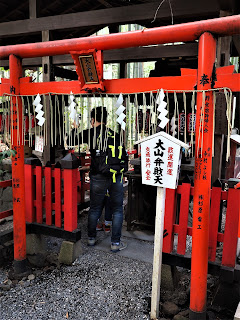




















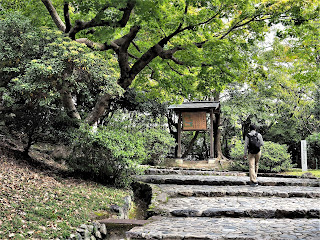













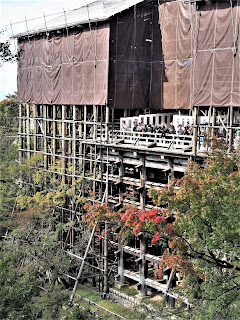




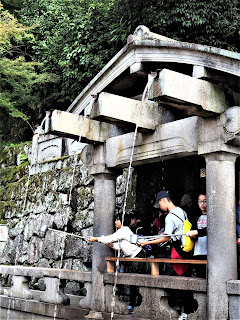












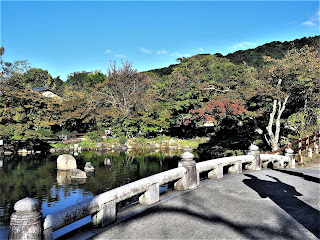










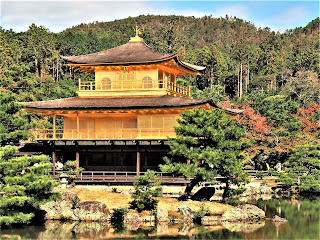





















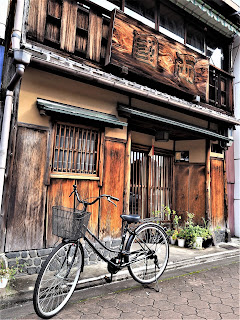








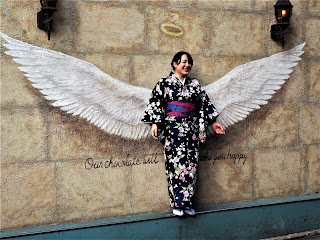







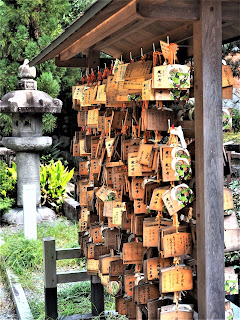





















No comments:
Post a Comment